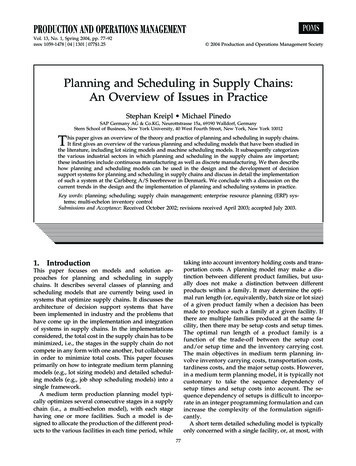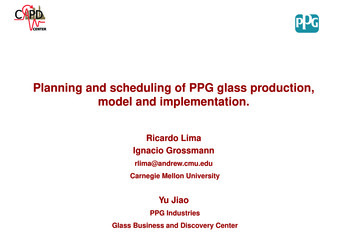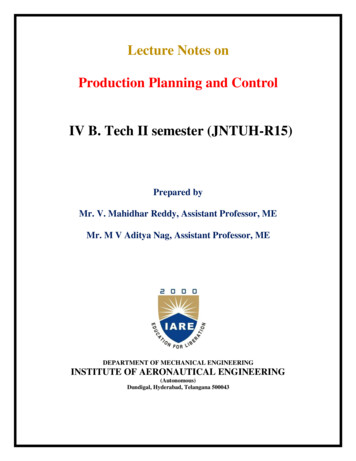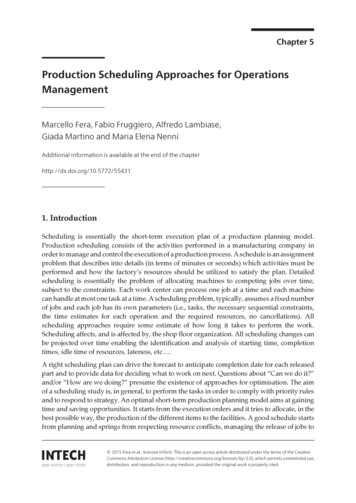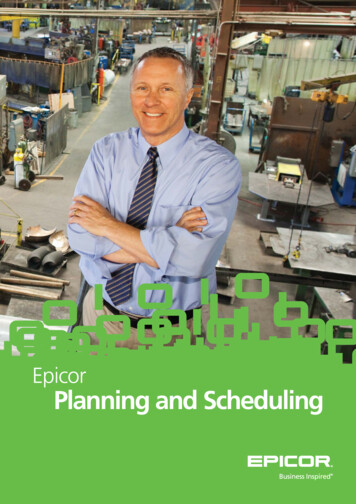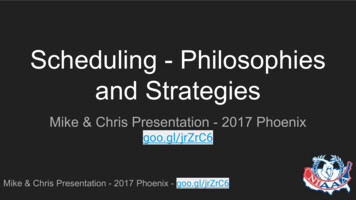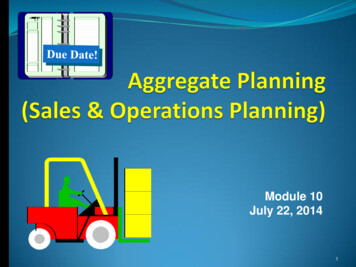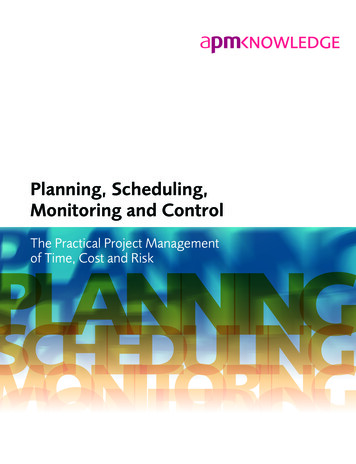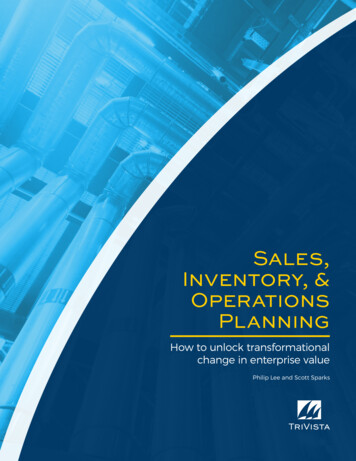
Transcription
PRODUCTION PLANNING AND SCHEDULING INMULTI-STAGE BATCH PRODUCTION ENVIRONMENTA THESISSUBMITTED IN PARTIAL FULFILLMENT OF THE REQUIREMENTSFOR THE FELLOW PROGRAMME IN MANAGEMENTINDIAN INSTITUTE OF MANAGEMENTAHMEDABADByPEEYUSH MEHTADate: March 15, 2004Thesis Advisory Committee[Chair][PANKAJ CHANDRA][Co-Chair][DEVANATH TIRUPATI][Member][ARABINDA TRIPATHY]1
Production Planning and Scheduling inMulti-Stage Batch Production EnvironmentByPeeyush MehtaABSTRACTWe address the problem of jointly determining production planning and schedulingdecisions in a complex multi-stage, multi-product, multi-machine, and batch-productionenvironment. Large numbers of process and discrete parts manufacturing industries arecharacterized by increasing product variety, low product volumes, demand variability andreduced strategic planning cycle. Multi-stage batch-processing industries like chemicals,food, glass, pharmaceuticals, tire, etc. are some examples that face this environment. Lack ofefficient production planning and scheduling decisions in this environment often results inhigh inventory costs and low capacity utilization.In this research, we consider the production environment that produces intermediateproducts, by-products and finished goods at a production stage. By-products are recycled torecover reusable raw materials. Inputs to a production stage are raw materials, intermediateproducts and reusable raw materials. Complexities in the production process arise due to thedesired coordination of various production stages and the recycling process. We considerflexible production resources where equipments are shared amongst products. This oftenleads to conflict in the capacity requirements at an aggregate level and at the detailedscheduling level. The environment is characterized by dynamic and deterministic demandsof finished goods over a finite planning horizon, high set-up times, transfer lot sizes andperishability of products. The decisions in the problem are to determine the productionquantities and inventory levels of products, aggregate capacity of the resources required andto derive detailed schedules at minimum cost.We determine production planning and scheduling decisions through a sequence ofmathematical models. First, we develop a mixed-integer programming (MIP) model todetermine production quantities of products in each time period of the planning horizon. Theobjective of the model is to minimize inventory and set-up costs of intermediate products andfinished goods, inventory costs of by-products and reusable raw materials, and cost of freshraw materials. This model also determines the aggregate capacity of the resources requiredto implement the production plan. We develop a variant of the planning model for jointlyplanning sales and production. This model has additional market constraints of lower andupper bounds on the demand. Next, we develop an MIP scheduling model to execute theaggregate sales and productions plans obtained from the planning model. The schedulingmodel derives detailed equipment wise schedules of products. The objective of thescheduling model is to minimize earliness and tardiness (E/T) penalties.We use branch and bound procedure to solve the production-planning problem.Demand of finished goods for each period over the planning horizon is an input to the model.The planning model is implemented on a rolling horizon basis.2
We consider flowshop setting for the finished goods in the production environment.The due dates of finished goods are based on the customer orders. We report some newresults for scheduling decisions in a permutation flowshop with E/T penalties about acommon due date. This class of problems can be sub-divided into three groups- one, wherethe common due date is such that all jobs are necessarily tardy; the second, where the duedate is such that the problem is unrestricted; and third is a group of problems where the duedate is between the above two. We develop analytical results and heuristics for flow shop E/Tproblems arising in each of these three classes. We also report computational performance onthese heuristics. The intermediate products follow a general job shop production process withre-entrant flows. We develop heuristics to determine equipment wise schedule ofintermediate products at each level of the product structure. The due date of an intermediateproduct is based on the schedule of its higher-level product.The models developed are tested on data for a chemical company in India. The resultsof cost minimization model in a particular instance indicated savings of 61.20 percent ininventory costs of intermediate products, 38.46 percent in set-up costs, 8.58 percent ininventory costs of by-products and reusable raw materials, and 20.50 percent in fresh rawmaterial costs over the actual production plan followed by the company. The results of thecontribution maximization model indicate 42.54 percent increase in contribution. We alsoperform sensitivity analysis on results of the production planning and scheduling problem.The contribution of this research is the new complexities addressed in the productionplanning and scheduling problem. Traditional models on multi-stage production planning andscheduling are primarily based on assembly and fabrication types of product structures anddo not consider the issues involved in recycling process. Scheduling theory with E/Tpenalties is largely limited to single machine environment. We expect that models developedin this research would form basis for production planning and scheduling decisions in multistage, multi-machine batch processing systems. The sensitivity analysis of the models wouldprovide an opportunity to the managers to evaluate the alternate production plans and torespond to the problem complexities in a better way.3
AcknowledgementsI wish to express my deepest gratitude to my thesis advisor Professor Pankaj Chandra.He has been a tremendous source of learning for me during my stay at IIMA. ProfessorChandra has been a great motivator, and has a significant share in my academic grooming.Much of the credit for this work goes to Professor Devanath Tirupati, co-chair of my thesiscommittee. He has been very patient with me and has provided very useful research training. Iwould also like to thank Professor Arabinda Tripathy, member of my thesis committee forproviding very useful feedback throughout my work.I am grateful to Professor Diptesh Ghosh, Professor P. R. Shukla, Professor AshokSrinivasan and Professor Goutam Dutta for their useful feedback on my thesis. I am alsothankful to Professor Shiv Srinivasan for giving some pointers on the drafting of thisdocument.I wish to especially thank my wife Ritu, as this thesis would not have been possiblewithout her support. She has a major share in raising our daughter Riti, and her break from herprofessional career helped me to stay focused on my work Riti always provided the muchneeded break from the thesis work. I dedicate this work to my parents. They have eagerlywaited to see me accomplish this work. Dhiraj, my brother, has been, as always, a source ofencouragement.I would like to thank my colleagues Bharat, Rohit, Satyendra and all those with whomI have interacted at various stages of my thesis. The staff members of FPM office, computercenter and library have obliged me in more ways than one.4
Table of Contents1Introduction. 91.1Introduction. 91.2Production Planning and Scheduling Problem . 121.2.1 Production Environment .131.2.2 Complexities in the Production Environment .161.2.3 Production Planning and Scheduling Decisions.181.3Summary. 192Literature Review . 212.1Integrated Production Planning and Scheduling Models . 222.2Hierarchical Production Planning and Scheduling Models . 292.3Earliness and Tardiness Scheduling. 342.4Research Gaps. 423Production Planning and Scheduling Models . 443.1Introduction. 443.2Production Planning Model . 463.2.1 Formulation of Production Planning Model.463.3Scheduling Models. 513.3.1 Finished Goods Scheduling Problem Formulation.523.3.2 Intermediate Products Scheduling Problem Formulation.543.4Summary. 564Solution Procedure for Production Planning and Scheduling Problem. 574.1Introduction. 574.2Solution Procedure for Production Planning and Scheduling Problem. 584.3Solution Procedure for Production Planning Problem. 584.4Solution Procedure for Finished Goods Scheduling Problem . 604.4.1 Sub-Problem 1: Flowshop E/T Problem for Unrestricted Common Due Date.654.4.2 Sub-Problem 2:Flowshop E/T Problem for Intermediate Common Due Date .674.4.3 Sub-Problem 3:Flowshop Tardiness Problem for Common Due Date.754.5Solution Procedure for Intermediate Products Scheduling Model . 794.6Dedicated Plant Scheduling Heuristic . 875
4.7Summary. 925Results of Production Planning and Scheduling Problem . 935.1Introduction. 935.2Results of Sub Problem 2. 945.2.1 Lower Bound of Sub Problem 2.945.2.2 Experiment Design of Sub Problem 2.955.3Results of Sub Problem 3. 1015.3.1 Lower Bound of Sub Problem 3 (Ahmadi and Bagchi, 1990) . 1025.3.2 Existing Results of Sub Problem 3. 1045.4Production Planning and Scheduling Results . 1105.5Summary. 1116Case Study: Application of Production Planning and Scheduling Models . 1146.1Introduction. 1146.2Production Planning and Scheduling Problem . 1156.3Application of Production Planning Model . 1176.3.1 Results of Production Planning Model. 1186.4Contribution Maximization Model . 1206.5Application of Scheduling Model. 1246.6Sensitivity Analysis on Production Planning and Scheduling Results . 1256.7Implementation Issues. 1286.8Summary. 1297Summary, Contribution and Future Research . 1347.1Summary. 1347.2Contribution. 1397.3Future Research. 141References. 144Appendices. 154Appendix 1: Product Structure Diagrams and Process Flow Diagrams . 154Appendix 2: Base Case Production Plan and Schedule . 164Appendix 3: Sensitivity Analysis on Production Planning and Scheduling Results . 1806
List of FiguresFigure 1.1: Multi- level Product Structure and Concept of Stage . 13Figure 1.2: Machines, Operations and Routes of a Product . 14Figure 1.3: Inputs and Outputs of a Production Process. 15Figure 4.1: Schematic of Solution Procedure for Production Planning and SchedulingProblem. 59Figure 4.2: Flowshop E/T Problem Decomposition Based on Due Dates. 64Figure 4.2: Conflict Removal at a Machine . 80Figure 5.1: Average % Deviation of Heuristic Solution from Lower Bo und: 5 Machines . 97Figure 5.2: Average of Deviation of Heuristic Solution from Lower Bound: 10 Machines . 98Figure 5.3: Average % Deviation from Optimal Solution and its Square Root . 99Figure 5.4: Improvement in the solution with Increase in Number of Tabu Iterations . 100Figure 5.5: Comparison of Results with Different Tabu Iterations . 101Figure 5.6: Average % Deviation of Heuristic Solution from Lower Bound: 5 Machines, SubProblem 3 . 106Figure 5.7: Average % Deviation of Heuristic Solution from Lower Bound: 10 Machines,Sub-Problem 3. 107Figure 5.8: Average % Deviation of Heuristic Solution from Lower Bound: 15 Machines,Sub-Problem 3. 108Figure 5.9: Average % Deviation of Heuristic Solution from Lower Bound: 20 Machines,Sub-Problem 3. 109Figure 6.1: Multi- Level Product Structure. 1157
List of TablesTable 2.1: Integrated Models in Discrete Parts Manufacturing Industries . 27Table 2.2: Integrated Models in Process Industries. . 29Table 2.3: Hierarchical Models in Discrete Parts Manufacturing Industries. 32Table 2.4: Hierarchical Models in Process Industries . 33Table 2.5: Single Machine Schedule with Earliness and Tardiness Penalties . 40Table 5.1: Parameters in Experiment Design of Sub-Problem 2 . 95Table 5.2: Average Percentage of Deviation of Optimal Solution from Heuristic Solution. 99Table 5.3: Production Plan of Finished Goods . 111Table 6.1: Comparison of Model Results with Actual Production Plan Costs . 120Table 6.2: Percentage Increase in ‘Revenue Net of Material Cost’ in ContributionMaximization Model as Compared to the Actual Sales and Production Plan. . 122Table 6.3: Production Costs Difference In Percentage: (Actual Production Plan–ProductionPlan Proposed by the Model) . 122Table 6.4: Sensitivity Analysis on Production Planning and Scheduling Results . 130Table 6.5: Capacity Utilization (in Percentage) of Dedicated Plants . 131Table 6.6: Capacity Utilization (in Percentage) of Machines in Flexible Plants . 1328
1Introduction1.1IntroductionToday’s business environment has become highly competitive. Manufacturing firmshave started recognizing the importance of manufacturing strategy in their businesses. Firmsare increasingly facing external pressures to improve customer response time, increaseproduct offerings, manage demand variability and be price competitive. In order to meetthese challenges, firms often find themselves in situations with critical shortages of someproducts and excess inventories of other products. This raises the issue of finding the rightbalance between cutting costs and maintaining customer responsiveness. Firms are facinginternal pressures to increase profitability through improvements in manufacturing efficiencyand reductions in operational costs.There are several instances in industry where the above-mentioned changes inbusiness environment have affected the profitability of firms. Harris Corporation, anelectronics company based in U.S.A., increased its product range considerably and investedin flexible manufacturing resources in the early 1990s. They had to provide competitive ontime delivery performance over a much greater product mix. Their inefficient handling of alarge product variety resulted in late deliveries, lost sales and average losses of 75 millionannually (Leachman et al., 1996). IBM faced record losses in 1993 in the manufacturing anddistribution operations of its computer business due to high operational costs. They could nothandle the high demand variability of their products and reported high inventory costs andstock outs (Feigin et al., 1996). Fuel inventory costs have risen considerably in electric utilityindustries in U.S.A. in the last two decades as a result of electricity demand fluctuations9
(Chao et al., 1989). H&R Johnson, the largest tile manufacturer in India, had to increase itsproduct variety in terms of size and design, in order to meet the demand of expandingconstruction market. This resulted in high inventory costs. Their customer response timeincreased considerably, resulting in loss of sales (Gupta, 1993). Synpack, an Indian chemicalmanufacturing firm, increased its product portfolio in the mid 1990s. However, it could nothandle the delivery commitments. The company’s market share reduced considerably andthey incurred high inventory costs (Akthar, 2004).Indian manufacturing firms are facing stiff global competition, especially from China.Today, China has become the world’s largest manufacturing base. China’s capability to offera large variety of products at low prices, and its fast responsiveness to the market hasseverely affected the sales of many Indian manufacturing firms. Indian companies are nowforced to be competitive on prices, increase product offerings, and have shorter lead times inproduction.The implications of the above–mentioned challenges in the business environment arethat manufacturing firms are now forced to focus on cost-leadership issues, optimize the useof available resources, and reduce their operational costs. They have to constantly exploremanufacturing strategies to meet these objectives.Since the mid 1980s, the business press has highlighted the success of manyJapanese, European, and North American firms in achieving a high degree of efficiency inmanufacturing (Silver et al., 1998). In recent years, many of these firms have started tocoordinate with other firms in their supply chain. For example, instead of responding todemand variability, firms share information with their partners to analyze demand pattern. It10
is observed that this notion, although useful, is not a sufficient way of facing some of thechallenges discussed earlier. Most managers assume that new levels of efficiency can beobtained simply by sharing information and forming alliances with their partners. They donot realize that information and data have to be used with very clear objectives. Here, the roleof inventory management and production planning and scheduling is introduced. Developingsound production planning and scheduling strategies may seem mundane in comparison tostrategy formulation, but it is observed that these strategies are critical to long-term survivaland competitive advantage.Production planning and scheduling help considerably in reducing operational costs,improving customer service and utilizing the resources optimally. In the examples discussedabove of high operational costs incurred by firms, significant savings have been realizedusing production planning and scheduling. By applying optimization based productionplanning system, Harris Corporation raised its on-time deliveries from 75 to 95 percentwithout increasing inventories and converted its huge losses to an annual profit 40 million.Over the past two decades, IBM's operations research team developed production-planningsystems and helped save hundreds of millions of dollars, while improving operations andcompetitive strategies. H&R Johnson implemented production-planning tools and reduced itsproduction lead times and inventory costs.Production planning and scheduling find their applicability in both discrete partsmanufacturing and process industries. APICS1 dictionary provides the key elements toclassify industries as process or discrete parts (Blomer and Gunther, 1998; Crama et al.,2001). More and more process industries are shifting to specialties market with customized1American Production and Inventory Control Society11
products and are no longer operating on make-to-stock policy alone. This is especially true ofbatch process industries such as pharmaceuticals, food, and glass, etc. These industries do notrestrict themselves to commodity products only. The first significant applications ofproduction planning and scheduling methods in process industries were in oil refineries, foodprocessing and steel manufacturing. Through the years, production planning and schedulingmethods have been developed and applied to process manufacturing of other products suchas chemicals, paper, soap and industrial gases.The main motivation for this research is to observe the potential benefits ofproduction planning and scheduling in manufacturing industries. The aim is to investigate thebenefits of production planning and scheduling in complex production environments.The remainder of this chapter is organized as follows. In the next section, we discussthe production planning and scheduling problem addressed in this research. We begin bydescribing the production environment in sub section 1.2.1. In sub-section 1.2.2, we discussthe complexities in the production environment. We describe the decisions to be addressed inthe production planning and scheduling problem in sub-section 1.2.3. The summary of thischapter is provided in section 1.3.1.2Production Planning and Scheduling ProblemIn this section, we describe the production planning and scheduling problemaddressed in this research. First we describe the production environment. The motivation forthe production environment considered in this research is largely from our observations oncharacteristics of chemical plants. Then we describe the complexities in the production12
environment. Subsequently we focus on the decisions to be addressed in the productionplanning and scheduling problem.1.2.1Production EnvironmentWe consider multi-stage production environment that produces both intermediateproducts and finished goods. A stage in the production environment corresponds to theproduction of an intermediate product or a finished good. The concept of multi-stage in theenvironment considered is equivalent to the multi-level product structure, as shown below forillustration in figure 1.1. In figure 1.1, level 0 products are finished goods (E1, E2, E3), level1 and level 2 products are intermediate products (I1,I2, I6). The levels in the productstructure diagram are various stages of the production process. For instance, level 1 and level2 in figure 1.1 are the intermediate products stages. The intermediate products at level 2 areinputs to the intermediate products at level 1. Level 1 intermediate products are inputs tolevel 0 products, which are finished goods, and at the finished goods production stage.Level 0E1E2E3Level 1I1I2I3Level 2I4I5I6Figure 1.1: Multi-level Product Structure and Concept of StageThe production environment has multiple production plants to produce intermediateproducts and finished goods. A production plant consists of number of equipment, called as13
‘machines’. Intermediate products and finished goods are processed on machines in aproduction plant in a specific order. The processing of a product on a machine is called an‘operation’. A ‘route’ is defined as the sequence of machines used for processing a product.To illustrate these concepts, we use figure 1.2 below. Consider a product ‘P’, it requires fouroperations in a production plant. There are five machines in the plant in this example(M1,M2,.,M5). As indicated in figure 1.2, there is choice of machines between M3 and M4for third operation. That is, based on the machine used for third operation of product P, thereare two different routes, Route 1 and Route 2 to produce product P. Route 1 comprisesmachines M1, M2, M3, M5 and Route 2 comprises machines M1, M2, M4 and M5.Route 1M3M1M2M5Route 2M4Operation 1Operation 2Operation 3Operation 4Figure 1.2: Machines, Operations and Routes of a ProductThere are two types of production plants in the production process. One is thededicated production plant. In the dedicated production plant, only one type of product isproduced. The second type is the flexible plant. In the flexible production plant, ni termediateproducts and finished goods share machines.A by-product is generated, when an intermediate product or a finished good isproduced in a production plant.A by-product consists of reusable raw materials. By-14
products are processed in a separate recycling plant, and some reusable raw materials arerecovered from the recycling process. Part of the raw materials that is not recovered for reusebecomes waste. Figure 1.3 shows the inputs and outputs of the production process andlinkages between the production plants and the recycling plants.Fresh Raw MaterialsIntermediatesIntermediate Products PlantBy ProductsFresh Raw MaterialsIntermediatesRecycling PlantFinished Goods PlantReusable Raw MaterialsBy ProductsFinished GoodsWasteFigure 1.3: Inputs and Outputs of a Production ProcessIt can be seen in figure 1.3 that inputs to production process in a plant are the freshraw materials, reusable raw materials and intermediate products. The outputs of a productionprocess from a plant are intermediate products, finished goods and by-products. By-productsare processed in recycling plants to recover reusable raw materials. Reusable raw materialsare used again as inputs in the production process.We consider flowshop setting for the finished goods in the production environment.In a flowshop, all products follow a similar route in a production plant. Intermediate productsfollow a general job shop setting with re-entrant flows. In a general job shop, the routes ofproducts are distinct. The characteristic of a re-entrant job shop is that jobs are processed ona particular machine for more than one operation.15
1.2.2Complexities in the Production EnvironmentIn this sub-section, we describe some of the complexities that exist in the productionenvironment. The production environment discussed in previous sub-section, and thecomplexities in the production environment, form the basis for production planning andscheduling decisions.As seen in figure 1.3, raw materials are recovered from by-products through arecycling process and reused in the production process. The recycling process is an importanttool in reducing the operational costs, as the cost of raw materials is very high. Maximumrecovery of the raw
PRODUCTION PLANNING AND SCHEDULING IN . FOR THE FELLOW PROGRAMME IN MANAGEMENT INDIAN INSTITUTE OF MANAGEMENT AHMEDABAD By PEEYUSH MEHTA Date: March 15, 2004 Thesis Advisory Committee _[Chair] [PANKAJ CHANDRA] . The decisions in the problem are to determine the production
